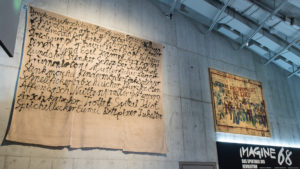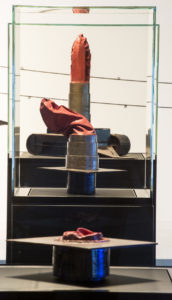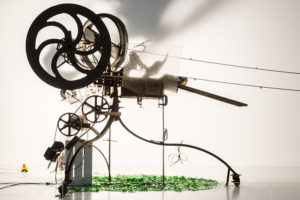
Swiss National Museum
Warhol, Tinguely, Polke and the escape into cursing
What demon had taken hold of Sigmar Polke when he created his ‘Schimpftuch’ in 1968? And what statement does Tinguely’s beer bottle-smashing machine make? We don’t know. What is beyond doubt, though, is that these artworks truly defined a style.
‘Scheisskerl’ (turd), ‘Eumel’ (dickhead), ‘Hurenbock’ (manwhore) – it’s not often that one is welcomed to an exhibition with this sort of language. For the current opening of ‘Imagine 68’, the National Museum is unleashing a torrent of abuse on its visitors. Once you’ve ascended the monumental staircase, passed by the aggressive-looking Bloodhound missiles and been grinned at by John Lennon on the big screen, you’ll be laid into by Sigmar Polke’s ‘Grosse Schimpftuch’, otherwise known as ‘the Great Bitching Sheet’ or ‘the Large Cloth of Abuse’: ‘Esel, Idiot, Speichellecker’ (jackass, idiot, brown-noser). In this exhibition opener, authority is roundly asserted, lampooned and attacked.
In 1968, the year of revolution, Polke filled the four-and-a-half-metre-square fabric sheet with rapid brushstrokes. Then, like a hybrid of Joseph Beuys and Rumpelstilskin, he flung it round his shoulders like a cape. In New York, where in 2014 the ‘Grosse Schimpftuch’ was hailed at MoMa as one of the artist’s key works, a US critic noted the similarity of Polke’s curvy, trickly letters to Jackson Pollock’s abstract dripping technique. It may be assumed that that critic did not understand German.
Even for us in Zurich, the terms of abuse are not always easy to make out. But they leave the viewer in no doubt as to the artist’s displeasure. Especially if you read Polke’s list aloud in a group, as Professor Philip Ursprung recommends exhibition visitors do. We tried it out recently with Dieter Meier, who is represented in ‘Imagine 68’ with early films and performances. The unmistakable voice of Yello became the driving force behind a liberating barrage of swearing in the Museum.
Smash bottles and float in silver clouds
But the question is, just what demon did Polke want to cast out with his ‘Schimpftuch’? And what demons seem to have possessed him at the time? There is no definitive answer to these questions. In the ‘Imagine 68’ exhibition, the question of the ‘message’ comes up not only in respect of Polke, but also with regard to the numerous other artists represented in the exhibition – there’s Jean Tinguely’s ‘Rotozaza’ machine, noisily smashing beer bottles, Claes Oldenburg’s ‘Lipstick (ascending) on caterpillar tracks’, Martha Rosler’s photo collages which brought the Vietnam War into smart American living rooms, Valie Export’s ‘Genital panic’ featuring the jeans with the crotch cut out, and even the old master of affirmation Andy Warhol and his silver clouds. They float like dim-witted sheep through a large cinema-cum-experience room, cluster in groups on the ceiling, or sink sluggishly to the floor.

Relic from the Cold War: the Bloodhound long-range missile, designed to fight bombers.
Swiss National Museum

Claes Oldenburg – Monument for Yale University: Giant Traveling and Telescoping Lipstick with Changeable Parts in Three Stages of Extension – Presentation Model, 1969.
Artist’s collection, New York

Jean Tinguely’s bottle-smashing machine Rotozaza No. 2 from 1967.
Swiss National Museum
All these artworks have something in common. After 50 years, they look as fresh as if they’ve just been released from a time capsule. They pursue no party political platform, and spread no propaganda. They are witness to the subjective creativity of young artists reacting to the events taking place around them, sometimes naively, crudely or, unwittingly, pioneering a style, as with the godfathers of pop. For all of them, the phrase used en passant by film director Fredi Murer as he strolled through ‘Imagine 68’ seems apt: ‘We had absolutely no idea what we were doing at the time, but it was incredibly exciting.’
Imagine 68 – The Spectacle of the Revolution
National Museum Zurich
14.09.18 - 20.01.19
Following the successful exhibitions “1900–1914. Foray into Happiness” (2014) and “Dada Universal” (2016), in 2018 Stefan Zweifel and Juri Steiner present their perspective of the generation of ‘68. The collage of the two guest curators, featuring objects, videos, photos, music and works of art, turns the atmosphere of 1968 into a multisensory experience. The exhibition takes a comprehensive look at this cultural time period, letting visitors float through Warhol’s Silver Clouds into a world of fantasies past.
Brief tour of the exhibition ‘Imagine 68. The Spectacle of the Revolution’ at the National Museum Zurich.



